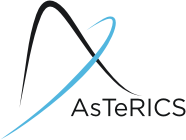Project Description
AsTeRICS provides an affordable construction set for building assistive functionalities which can be highly adapted to individual user needs. The system is scaleable and extensible, so that new functions can be integrated without major changes. Furthermore, AsTeRICS opens access for people with severe motor disabilities to various embedded devices and mobile services, which did not offer highly specialised user interfaces before.
These features are made possible due to a system architecture which is composed of modular functional hardware and software components perfectly suited for utilisation in various Assistive Technology applications:
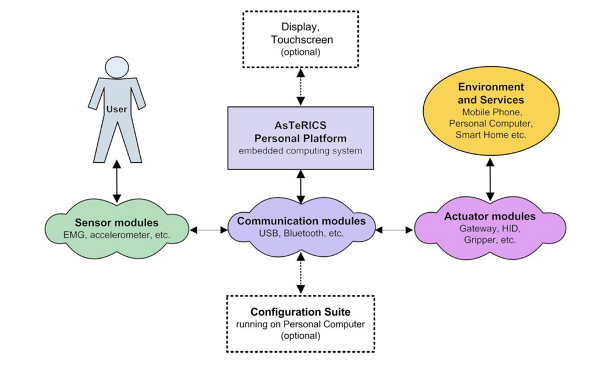
- Figure 1: Concept of the AsTeRICS modular Assistive Technology system
Figure 1 outlines the concept of the AsTeRICS construction set, which contains several modules and a software suite for configuration of the system. The core element of the AsTeRICS system is the AsTeRICS Personal Platform, an embedded computing system which processes data from input modules and controls output to actuator modules. Configurations can be designed using a graphical software suite and downloaded into the AsTeRICS personal platform to perform the desired functions.
AsTeRICS is designed to extend the possible input- and output modalities as far as possible. In the course of the project, several modules which support a wide range of use-cases were developed, including biosignal acquisition for BCI operation and neural interfaces, computer vision based user interaction and utilisation of environmental control systems via an off-the-shelf gateway. These diverse use-case implementations help to highlight the flexibility and potential extension of the system.
As individual users don't need the complete set of sensors and actuators, particular applications only use appropriate modules. In this way, AsTeRICS can provide cost-effective alternative AT-solutions which are highly customisable to the individual requirements of each person. The graphical configuration editor gives therapists or caregivers the opportunity to change or adapt system settings without deep technical knowledge. The user will therefore benefit from a tailored AT device which will be able to be used more effectively, efficiently and with more user satisfaction. AT adaptation or implementation is affordable and has never been so easy even for "extreme user needs".
On the other hand, IT-professionals and rehabilitation engineers can extend the system to work with new input or output modalities. This is made possible by using a standardised Service Oriented Architecture and component based software approaches (e.g. OSGi), and by keeping the interfaces to the open source AsTeRICS software framework clear and well documented.
The AsTeRICS Personal Platform
The AsTeRICS Personal Platform is the central module of the AsTeRICS stand alone system which allows the interaction of (body-near or embedded) sensors and actuators and makes assistive functionalities possible.
Sensors and actuators are connected to this embedded computing platform by wire or wirelessly. The incoming signals from the sensors are processed (e.g. filtered, transformed etc.) and used to control the actuators. The OSGi-based system architecture enables dynamic pluggability of (new) processing components and the integration both of (new) sensors and actuators. This can ensure that only the software components necessary for the desired system configuration are selected and used.
The Communication Interface Modules
The Communication Interface Modules (CIMs) support the information transfer between the main system components: they link together the AsTeRICS Personal Platform, the sensor- and actuator modules and the Personal Computer for system configuration. The CIMs are put in place using mechanical sockets of the hardware platform. Furthermore, the CIMs can connect the AsTeRICS system to existing standardised solutions for environmental control, e.g. a home automation gateway.
The Sensor Modules
The sensor modules make classic solutions for AT available - e.g. mini joysticks, accelerometers, strain gauges or sip/puff-switches. In addition to these off-the-shelf sensors, two multi-purpose input modules are developed and integrated into the AsTeRICS system:
- The Smart Vision Module is a configurable VLSI computer vision sensor which is developed by the consortium partners UPMC and FHTW. It can be used to extract special features from live image frames and to detect movements of the user.
- Enobio® is a wearable, modular and wireless electro-physiology sensor system for the recording of EEG (electroencephalogram), EMG (electromyogram) and EOG (electrooculogram). Enobio® can be used as sensor for Brain Computer Interfacing (EEG-BCI) or muscle triggered interaction.
Due to the openness of the construction set, also other sensors or biosignal amplifiers can be readily added in the future. It was one of the core goals of AsTeRICS to demonstrate extensibility and sustainability by including further modern sensor techniques which might become available during and after the project.
The Actuator Modules
The actuator modules provide the AsTeRICS system with an effective interface to the environment or to other ICT devices. One class of actuators implement standard Human Interface Devices (HIDs), i.e. standard keyboard and standard mouse. These modules can directly be connected to a Personal Computer via the USB port and will emulate a mouse and/or a keyboard without requiring special driver software. Other actuator modules enable access to embedded services like a home automation gateway or mobile phones.
Optional Display with Touchscreen
The display with touchscreen can be seen as special actuator/sensor module which present AT interfaces to the user (e.g. UI of a virtual keyboard or mouse which supports scanning). If desired, the touchscreen can be used to select different system modes, start or stop a configuration, etc. The display is also be useful for adaptation of the AsTeRICS runtime parameters. The display and the Communication Interface Modules can be plugged onto the AsTeRICS Personal Platform and extend its features if required.
The AsTeRICS Configuration Suite and AsTeRICS runtime system components
The Configuration Suite provides the interface to set up and configure the AsTeRICS framework. The sensor and actuator modules are represented by graphical symbols with input and output connectivity. Additionally, an extensive set of signal processing components, data analysis functionalities and specialised user interface components is provided by the Configuration Suite. Desired components can be put into a design window and linked together simply by drawing a connection using the computer mouse and/or keyboard. A connection of two modules in the design window generates a physical data flow between those two modules in the real world. By using the configuration suite, the following characteristics of the overall system can be defined:
- The functionality (mapping sensors with actuators)
- The behaviour (calibration, reaction time, accuracy, tremor reduction)
- The look & feel of the user interface (e.g. symbols or letters on the display/touchscreen)
Using the Configuration Suite, prototypical AT-solutions can be set up either by experts or by those having proper expertise in tailoring AT for end users. As the graphical user interface follows an accessible Design-For-All approach, people with disabilities or their related parties can “self configure” and fine-tune the system parameters according to advancements of the user or changing needs.
The Configuration Suite is connected to the runtime system via a TCP/IP connection. Therefore it is also possible to configure an AsTeRICS system from a remote PC connected via the Internet. This opens up the possibility for remote support of users and/or carers who are setting up the system and should help towards keeping maintenance cost down.
Personal Platform
The AsTeRICS Personal Platform is a mobile computing system with dedicated extensions for AT interfaces. It could be considered as a mobile Mini-PC with Windows Embedded Standard-7 operating system, which has additional capabilities for sensor- and actuator connections and an integrated OLED Display with touchscreen to select desired models. The Personal Platform core module provides 3 connectors for digital switches, 2 analogue input connectors, 2 control digital output connectors, 6 USB ports, Ethernet/LAN, WiFi, Bluetooth 2.0, a DVI connector and Analogue Audio (in/out).
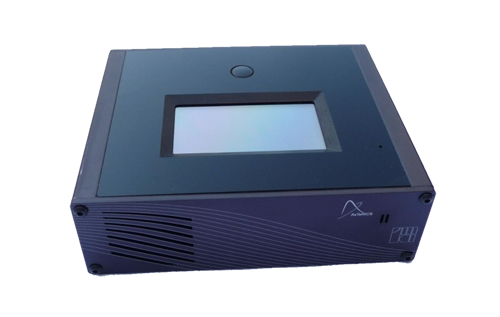
A single board computer with Intel Atom CPU is the core computing module in the Personal Platform. The CPU runs at 1,6 GHz, the on-board RAM is 2GB. A built-in SSD provides 64GB of memory for operating system, drivers and the AsTeRICS software. The Personal Platform contains an internal backup battery which allows to run the platform from 0.5 up to 2 hours depending on the peripherals connected and the running configuration complexity.

Certain types of sensors and actuators can be directly interfaced to Personal Platform (without an additional expansion module):
3 x Digital Input
to connect digital switch type sensors, for example standard AT input switches
3.5 mm mono Jack connector
represented in the ARE by the “PlatformDigitalIn” sensor plugin
2 x Analogue Input
to connect analogue sensors like a strain gauge or pressure sensor
universal voltage or resistive input
voltage input range 0 – 5 V
Resistive input range 10 Ohm - 1.5 MOhm
2.5 mm stereo Jacks connectors
represented in the ARE by the “PlatformAnalogIn” sensor plugin
2 x Digital Outputs
to control external loads or appliances
Open Collector, approx. 500 mA current limit
4-pin connector with additional 5V power supply
represented in the ARE by the “PlatformDigitalOut” actuator plugin
6x USB 2.0 HiSpeed, Ethernet/LAN, WiFi 802.11 b/g/n, Bluetooth 2.0
to connect various AT devices via these standard interfaces
Analogue Audio Input and Output
internal speaker and microphone with option to connect external ones
for voice control and speech synthesized output
CIM Container
The Personal Platform core module can be extended with an attachable container for Communication Interface Modules. The CIM container features 3 slots for desired CIM Modules. This makes it possible to use the Personal Platform in two variants:
Light Personal Platform variant without the expansion slots as a small compact option which is sufficient for many use cases
Full Personal Platform variant with the expansion slots for additional input/output capabilities
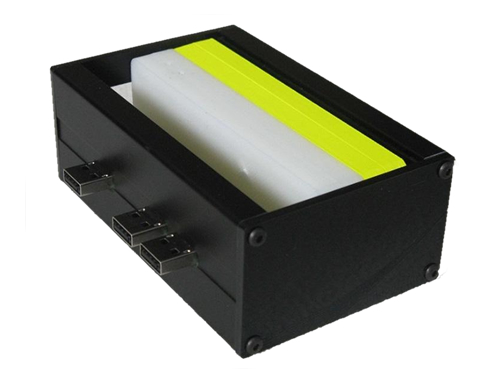
The connection of the CIM expansion container is accomplished via 3 standard “Type-A” USB ports at the side of the CIM container and the Personal Platform respectively (this occupies 3 of the 6 free USB ports of the platform). The mechanical connection is mechanically stable due to 4 screws.
The CIM Container serves also as a compact box for CIM modules with AsTeRICS software running on a standard PC or a netbook.
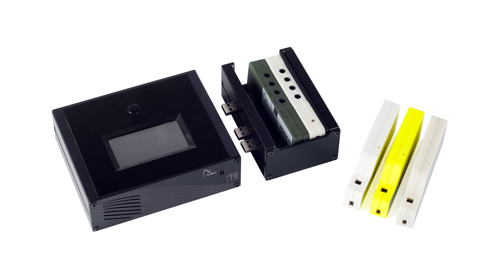
GPI CIM (or DigitalIn CIM)
The DigitalIn Communication Interface Module serves for further expansion of the Personal Platform with additional digital input or can be used as a stand-alone unit connected to a PC via USB interface.
6 x Digital Input
to connect digital switch type sensors, for example standard AT input switches
3.5 mm mono Jack connector
represented in the ARE by the “DigitalIn” sensor plugin
GPO CIM (or DigitalOut CIM)
The DigitalIn Communication Interface Module serves for further expansion of the Personal Platform with additional digital input or can be used as a stand-alone unit connected to a PC via USB interface. In case it is connected to a standard PC, the output current is limited by the host USB port.
5 x Digital Output
to control external loads or appliances
3 x 4-pin connector with Open Collector, approx. 500 mA current limit and additional 5V and 12V power supply
2x 3-pin connector with NC/NO relay output, 1A/50V
represented in the ARE by the “DigitalOut” actuator plugin
ADC CIM (or AnalogIn CIM)
The AnalogIn Communication Interface Module serves for further expansion of the Personal Platform with additional digital input or can be used as a stand-alone unit connected to a PC via USB interface. The resistive- and voltage-type sensors can be connected.
2 x Analogue Input
to connect analogue sensors like a strain gauge or pressure sensor
universal voltage or resistive input
voltage input range 0 – 5 V
resistive input range 10 Ohm - 1.5 MOhm
2.5 mm stereo Jacks connectors
represented in the ARE by the “AnalogIn” sensor plugin
Dummy USB CIM
The Dummy USB CIM has no special functionality. In case not all slots in the CIM Container are used, this module can be used to fill in the gap and additionally to route the unused USB interface outside the container for further expansion.
Universal HID Actuator
The Universal HID Actuator module is a USB dongle which acts as a mouse-, keyboard- and joystick-device on a remote system. Thus, no driver software is needed on Mac/Linux or Windows computers to allow for a control of these standard input devices. The control information (for example x/y mouse cursor position and clicking commands) are sent from the ARE (running on the Personal Platform or on a Laptop/Netbook computer) to the HID actuator dongle via a Bluetooth wireless connection or via a USB cable.
The HID Actuator is of special interest for gaming because it allows to completely replace a PS3 “sixaxis” controller for the PlayStation 3 gaming console. Thus, dedicated system models can be generated to use desired sensors to control PS3 games via the HID actuator.
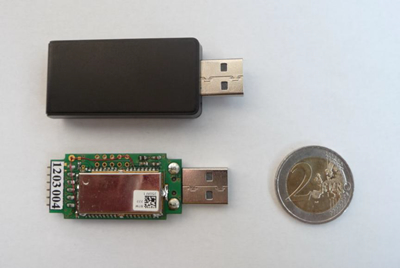
The following figure shows the connection of the HID actuator to the remote (“host”) system:

3D Accelerometer Sensor
The 3D Accelerometer Sensor can be used for motion and tilt detection. A miniature box with flexible wristlet allows attaching the sensor to a body part. The sensor is connected to the AsTeRICS system via 1.5m USB A-type cable.
